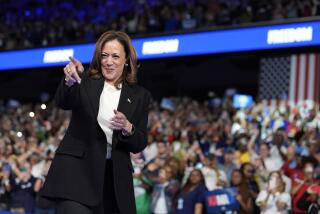Put California on Par With New Hampshire
Earlier this year residents of a small New England state with a population roughly equivalent to that of California’s Alameda County were able to eat breakfast, share war stories and then intimately discuss the future of America one-on-one with presidential candidates. On Feb. 20, the nation watched as New Hampshire voters played a major role in determining who would be the nominees for president.
Why New Hampshire? Why not Alameda County? Each has about 1.5 million residents and 700,000 registered voters. It can be argued that Alameda County, with its three professional sports franchises, world class university and major international port adds more to America’s gross national product than several entire states.
Then why is it that Alameda County, or California, for that matter, does not enjoy the major league clout that New Hampshire and other states wield during the presidential nominating process?
This year, the Republican and Democratic parties’ presidential nominations essentially were decided by Feb. 27 in South Carolina. The population of all the states that voted on or before that date is roughly two-thirds the population of California.
Legislation has been introduced in California to push our primary up to the first Tuesday in February. That would only aggravate the national problem. The real solution must come by addressing the entire nation’s primary system.
Understanding that no state wants to be ignored in the presidential selection process, the National Assn. of Secretaries of State has established a committee to develop a plan that will be fair to everyone.
The preliminary plan is to divide the country into four or five geographic regions, with each region having its own primary election day. The order of the primaries would rotate so that each region would have the opportunity to begin the process.
The regional primary system makes sense for a number of reasons. Aside from the increased fairness to voters, it will prevent states from engaging in election day leapfrog, trying to jump ahead of others.
By implementing regional primaries and holding the elections later in the year, we would nominate candidates closer to the general election and have a shorter campaign season.
Before the regional primary plan can be implemented, a national consensus must be developed to ensure that the most fair and equitable solution be adopted.
However, it is important to note the NASS committee preparing the plan is chaired by New Hampshire Secretary of State Bill Gardner. His involvement demonstrates that even the states that benefit from the current system realize that something needs to be done.
Drafting and revising a plan that can be adopted nationally is the next major hurdle. A NASS subcommittee will meet this weekend to develop recommendations to improve the nominating process.
I would like to know the scope of support or opposition to this plan in California. As vice chair of the NASS Committee on Elections, I will make sure California’s voice is heard.
More to Read
Get the L.A. Times Politics newsletter
Deeply reported insights into legislation, politics and policy from Sacramento, Washington and beyond. In your inbox three times per week.
You may occasionally receive promotional content from the Los Angeles Times.










